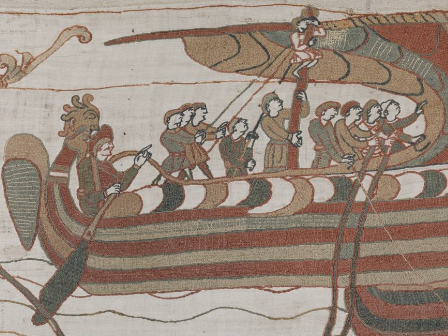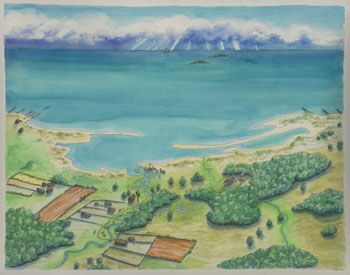
The Voersaa Rudder
Denmark’s best preserved side rudder from the Viking Era
The unique rudder proves that there was activity on the North Jutland east coast as early as the Viking Age. In addition it tells about impressive engineering knowledge and refers back to the world famous Bayeux Tapestry. Now the exhibition of the rudder has been updated with help from the Spar Nord Foundation.
The journeys of the Voersaa Rudder
In the Viking Age the rudder was used for maneuvering a merchant ship that may have sailed between Denmark, Norway and Sweden. At some point the rudder ended on the seabed where it lay hidden for 1,000 years. The rudder had been covered by sand on the sea bed which is important as it has preserved the natural condition of the rudder.
One day in the early summer of 1958 Riis Sørensen, a skipper from Læsø, caught a big wooden object in his trawl while fishing approx. 2 kilometres from Voersaa. He realized that it was not just an ordinary piece of driftwood and brought the object ashore. After a few days in Læsø it was sent to Bangsbo Museum (now The Coastal Museum of Bangsbo) as a gift. Here they realized that it was an exceptionally well preserved copy of a side rudder from the Viking Age. The rudder was dated back to the middle of the 10th century where Harald Blåtand and Knud den Store lay claim to Denmark and Norway.
The journey from Læsø to Bangsbo is only a small part of the total adventures of the rudder. In 1980 the rudder was on exhibition in both London and New York, at The British Museum and The Metropolitan Museum respectively.
In 2006 the rudder once again was lent out – this time to the National Museum of Denmark in Copenhagen and later to Bayeux in Normandy, France. In both places the rudder was exhibited together with the Bayeux Tapestry, which is a 70 metres long tapestry depicting the strife about the English throne. The Voersaa rudder was exhibited along with the Bayeux Tapestry because we see the same type of side rudder in the tapestry.
After many and long journeys the Voersaa Rudder returned home again. The rudder found its stationary place in the hall of the Ellingaa ship at the Coastal Museum of Bangsbo where it has been on exhibition for many years. However, new times meant new worries about the safety of the rudder. Therefore the rudder has received a new mounting which protects the rudder and communicates its history in a far better way. The new mounting of the rudder was made possible with support from the Spar Nord Foundation.
Where is the ship?
When the rudder was found and identified as a rudder from the Viking Age, it aroused big interest in finding the Viking ship from which it came. And great efforts were actually made. However, despite several attempts with diving in the area outside Voersaa the ship was never found. It may still be lying buried in the sand outside Voersaa.
The Ellingaa Ship
The Voersaa rudder is exhibited in the Ellingaa Ship’s Hall. The two items both bear witness about life and activity in the area already in the Viking Age and up to the early Middle Ages. The Ellingaa Ship was found in the stream Elling Å north of Frederikshavn and dates back to 1163. We also use the phrase “the Viking ship from the Middle Ages” about it because it shares much of its building technique with what we know from the Viking Age. It shows in a unique way the development in building technique from the Viking Age to the early Middle Ages. The side rudder from the Ellingaa Ship was never found. The Voersaa rudder, however, is a similar rudder and therefore a great item to exhibit along with the ship.
A proof of activity
Before there were roads and bridges, airlines, internet and telecommunication in Scandinavia all contacts between the countries took place by sea. Whether a ship was loaded with soldiers or merchandise, whether it brought war or peace the sea made it possible.






